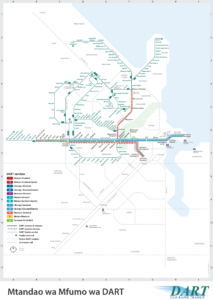
February 11, 2022
Optimising BRT operations in Dar es Salaam
In 2016, the city of Dar es Salaam launched the first phase of its BRT system. The BRT, a first in the East Africa region, was timely as the city was grappling with increasing transport needs that the informal daladala sector was unable to meet. The BRT is an essential mobility link in the city, which is now home to over 6 million people.
The first-phase BRT corridor has 21 km of dedicated median bus lanes running from Kimara to Kivukoni along Morogoro Road, Sokoine Drive, and Kivukoni Front, with branches from Fire to Gerezani along Msimbazi Street and Magomeni to Morocco along Kawawa Road. This trunk system has one depot at Jangwani, five terminals, and twenty-seven median stations.
The system is regulated by the Dar es Salaam Rapid Transit agency (DART), with bus services run by Usafiri Dar es Salaam Rapid Transit (UDART). UDART was established by bus operator Usafiri Dar es Salaam (UDA), incorporating both the public and the private sectors, as well as former daladala operators.
At the start of the BRT operations in 2016, the line 1 corridor with a bus fleet of 140 buses was extremely successful, cutting travel times by over 50 percent and serving approximately 200,000 people a day. At the outset, the system generated revenues of up to TZS 130 million. However, over the years, the system has experienced challenges such as station and bus overcrowding, insufficient off-peak service, and irregular headways. Many of the service quality issues stemmed from an inadequate fleet size.

When the system opened, there was no tendering process for bus operations and services were offered on a net-cost basis under a monopoly, leading to lack of control over the quality of service. The operator was also facing financial challenges due to high operational costs, exacerbated by damage to buses caused by floods at the Jangwani bus depot and the nearby roads, which at times were rendered impassable. By 2020, revenue collection had fallen significantly, prompting the government to take action.
In 2019, the government increased its stake in the ownership of UDART from 51 percent to 85 percent to mitigate against the financial challenges and also provide technical support. This year, following interventions from the government, significant improvements are being made to improve reliability and quality of service. UDART has expanded its bus fleet by putting into operation an additional fleet of 70 articulated buses, bringing the total fleet to 210 buses. The larger fleet is expected to increase coverage and reduce waiting times. The government is now constructing a mini depot at Ubungo to supplement the one at Jangwani, which is prone to flooding. With financing from the World Bank, plans are also underway to improve resilience in the Msimbazi river basin by improving drainage into the Indian Ocean.
When fully operational, it is expected that the first-phase corridor will carry 635,000 passengers per day, making it the busiest BRT system in Africa. In order to achieve the planned operational target, additional buses will be required. Early this year, the government floated bids for a second bus operator who will bring in a fleet of 95 buses. Procurement is currently at an advanced stage, and the contract with the winning bidder is expected to be signed in the first quarter of 2022 with the operations of the additional buses starting soon after.
Plans are underway to integrate information technology services (ITS), including real-time customer information, signal priority at intersections, and a revamped smart card fare collection system. Automated vehicle tracking is expected to improve operational efficiency and provide data on how best to utilise BRT buses to minimise wait time. DART is also developing a roadmap for the introduction of clean vehicles, including e-buses and electric three-wheeler feeder services.
In order to enforce quality of service and reliability, DART plans to move to a gross cost contracting model where payment to bus operators will be based on the number of kilometres travelled. The government will receive revenues from an independent fare collection company, allowing it to withhold payments to the bus operators if services are substandard.
Quality BRT operations are expected to result in a mode shift from private vehicles and informal modes, significantly improving the quality of life for Dar es Salaam residents. As the system expands into phases 2, 3, 4 and 5, operational efficiency backed by strong political will are key to the success of the system. As emerging economies continue to urbanise, investments in high-quality public transport are more imperative than ever in shifting away from the status quo of private vehicle dependence. We look forward to seeing Dar es Salaam continue as an African trailblazer on the path toward sustainable mobility.

